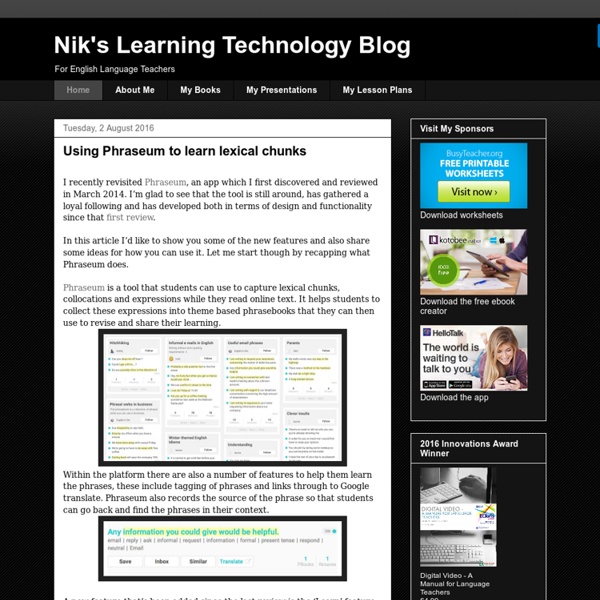



http://nikpeachey.blogspot.com/
Related: Flipped 3gettingsmart According to Common Sense Media, 95% of teachers agree that using technology increases student engagement and 92% of teachers want to add more technology to their classroom. We at Getting Smart are still basking in an ISTE afterglow… we’d like to share 10 great tools that we were introduced to there and the reasons they are so worth taking the time to master this summer. These are the tools that will transform your classroom in the fall because you will notice the definite threads that run throughout all these applications… real-time, collaborate and creative!
Ellclassroom Over the course of my 15 years of teaching in the classroom, there has been a continual debate over management vs. engagement. The argument is that if you create an engaging lesson, then management issues will fade away like a bad stain in the washing machine. The opposite has also been stated, if you have good management then “engagement” (which has been confused with compliance, in this instance), also increases. Top 10 Free Online Mind Mapping Tools As the name, mind mapping means that to draw your mind or ideas as a map, which are well-known for brainstorm, exploring your brain for many ideas. For mind mapping, you can just use a pen and one paper, but it will be funny and easier if you are using below tools, which are all available for you to create mind maps online for free without anything to download or install. 1. Bubblus
Teachers Teaching Teachers, on Twitter: Q. and A. on 'Edchats' A screenshot from TweetDeck showing, left, a recent #Edchat stream and, right, the #Engchat stream at the same time. Like other groups with shared interests, from epidemiologists to James Joyce fans to locked-out N.F.L. players, teachers are turning to Twitter to collaborate, share resources and offer each other support. Many, in fact, are using it to take professional development into their own hands, 140 characters at a time. Each week, thousands of teachers participate in scheduled Twitter “chats” around a particular subject area or type of student. Math teachers meet on Mondays, for instance, while science discussions happen on Tuesdays, new teachers gather on Wednesdays and teachers working with sixth graders meet Thursdays.
Becoming a teacher trainer « elteachertrainer Many teacher trainers are people with extensive knowledge and experience of the subject. They have probably taught many different levels of student, different class sizes, cultures, nationalities, age ranges and students with different needs – from young learners through to adults with specific work-related requirements. Your CV or resume won’t cover every part of the ELT spectrum, but you’ll be a reasonable ‘jack of all trades’ and perhaps even a reasonable specialist in one of two of them. Longevity in ELT is often a job requirement for teacher training and most teachers who move into it have been in the profession for some considerable time. However, the first signs of wanting to train can, in fact, emerge at an early stage of a teacher’s career. You’re standing in the teacher’s room organising some materials for your next lesson and someone asks you what you’re doing with your students today.
Game Building Resources The best FREE resources of game building for teachers and children: Building games for teaching Teach with Portal – Today, innovative educators are finding ways to incorporate Portal™ and Portal 2 into their classrooms—helping teach physics and critical-thinking skills. It’s eye-opening to see how video games can be used in amazing and unexpected ways to help educate our next generation.
English Raven The idea of disintermediation ("cutting out the middle man") in terms of professional qualifications has been slowly but surely gathering steam in a variety of fields. Take a look at a range of Position Descriptions for new jobs these days and phrases along the lines of Tertiary qualifications in a relevant discipline, or equivalent experience and expertise/skills are becoming more frequent. Private companies (as we might expect) have been quicker to apply this in practice rather than rhetoric compared to educational institutions, mired as most of them are in conservative paper-reliant processes for verifying applicants' skills, but even here we are starting to see change. Powerful tool for creating web surveys. Online survey software made easy! SurveyMonkey™ Thanks for completing this survey.Now create your own—it's free, quick & easy! Create free surveys in just a few minutes Ask questions in over 15 formats(configured for you and ready to go!)
Ways to Evaluate Educational Apps I am conducting a series of workshops in Florida and was asked to share a rubric to help teachers evaluate educational apps as part of the workshop. In 2010 Harry Walker developed a rubric, and I used his rubric (with some modifications by Kathy Schrock) as the basis for mine. (Read Harry Walker's paper Evaluating the Effectiveness of Apps for Mobile Devices.) I kept in mind that some apps are used to practice a discrete skill or present information just one time. Others are creative apps that a learner may use again and again, so it's a challenge to craft a rubric that can be used for a wide span of purposes. I tried to make my rubric work for the broadest range of apps, from drill and practice to creative endeavors, while stressing the purpose for using the app.